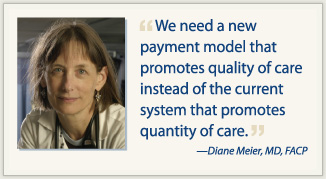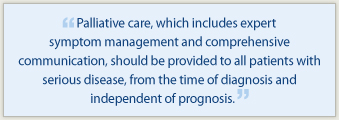More than half of our nation’s patients with cancer are Medicare beneficiaries, making the entitlement program ground zero in the heated debate on health-care spending. Total Medicare expenditures attributable to beneficiaries in their last year of life runs upward of 30%; this statistic serves as a rallying point for the charge that too much expensive care is used in advanced cancer. However, according to nationally regarded palliative care expert, Diane Meier, MD, FACP, Director, Hertzberg Palliative Care Institute, Mount Sinai School of Medicine, New York, our fragmented delivery system is what we should be focusing on. Dr. Meier recently spoke with The ASCO Post, offering her perspective for our ongoing series on rising cancer costs.
Key Cost Driver in Cancer Care
Several studies indicate increased hospital use among patients with cancer is becoming a key driver of costs. What’s your response to these findings?
It is an accurate assessment; however, increased hospitalizations are a symptom of a systemic problem. Patients turn to the hospital because their needs are not being met in the community setting. There is no safety net in place, no appropriate support for caregivers and patients, so they have no alternative but to call 911. More than 70% of patients with cancer who are admitted to the hospital enter through the ER. This is just one fact that illustrates how fundamentally broken our health-care system is.
Whole-person Care
Short of scrapping the system and starting over, how can we fix the broken part of the cancer care component?
It has been repeatedly demonstrated that if you deliver high-quality, patient-centered palliative care focused on providing quality of life and an extra layer of support to caregivers, patients, and their oncologists, patients’ needs are met in a timely manner so that they do not have to go through the kind of crises that send them to the ER. Plus they have fewer psychosocial issues such as depression, stress, and worry, and, perhaps as a result, are more likely to complete their cancer treatments.
It’s a no-brainer that if the whole person—and I include the patient and family as the unit of care—has his or her respective needs met comprehensively and continuously throughout the course of illness, we can anticipate, prevent, and manage costly crises, such as emergency hospitalizations and all the inpatient treatments that follow. An emergency hospitalization is good for no one; patients are better off (and safer) at home, and the costs of using the hospital as the crisis default are astronomical.
What you described sounds like it should be standard of care. Why isn’t it?
In short, because we do not have a payment system in place that promotes whole-person care. The current payment system rewards highly specialized and fragmented medical care. We are throwing money out the window by the handfuls. Unnecessary hospital admissions are an example, not only for costly ER stays, but because hospitals are dangerous places for immunocompromised patients with cancer who are highly susceptible to nosocomial infections. So if we really want to improve quality of care and, as a side effect, markedly reduce spending, we will move these patients and provide the care they need back in the community—basically, into their homes.
Changing Policy
How can we make that kind of transformation in cancer care?
We need a new payment model that promotes quality of care instead of the current system that promotes quantity of care. We need to pay for doctors, nurse practitioners, social workers, and others to come to the house and be available on a 24/7 on-call basis. For example, if on a Saturday night a family caregiver suddenly realizes that pain  meds will run out the next morning, or that the patient hasn’t had a bowel movement in 6 days and has abdominal pain, a call to the oncologist would probably elicit this advice: “Go to the ER.” However, if a palliative medical care home team is contacted, they would know which 24-hour pharmacy delivers in that area or could get a nurse to the house right away to administer enemas. Two phone calls and an emergency department visit, and hospitalization is averted.
meds will run out the next morning, or that the patient hasn’t had a bowel movement in 6 days and has abdominal pain, a call to the oncologist would probably elicit this advice: “Go to the ER.” However, if a palliative medical care home team is contacted, they would know which 24-hour pharmacy delivers in that area or could get a nurse to the house right away to administer enemas. Two phone calls and an emergency department visit, and hospitalization is averted.
Palliative care team members are trained and skilled and rewarded for meeting the whole patient’s needs in the home setting, thus avoiding unnecessary hospitalizations. It’s a systems problem, not a patient or cancer problem; we designed the delivery system based on financial incentives that are misaligned. That needs to change.
‘End-of-life Care’
Medicare spending for end-of-life cancer care is one area that policymakers single out for cuts. What’s your take on this issue?
In our ongoing dialogue, it is very important not to frame the issue as “end-of-life care” because that suggests we are giving treatment that we know will not help to patients who we know are dying, and that is simply not the case. An oncologist doesn’t know if a patient is going to be in the 50% of those who survive 3 to 4 years with non–small cell lung cancer, or in the 50% who die sooner.
Retrospectively citing a cost statistic attached to the phrase “end-of-life care” suggests that we know with certainty which patients should fall into that category, and the fact is, we don’t. As doctors, we have to give 100 patients the same treatment to capture the 50 who will respond and live an extra 3 to 4 years. The other 50 may not make it, but we don’t and can’t know that in advance. We need to give all our patients who could realistically benefit the same opportunity to have the best care possible.
Productive Conversations
Is part of treating the whole patient and, in turn, delivering more cost-effective care, attained by developing better communication about realistic goals when the patient moves from the curative option setting, as articulated in the recent ASCO policy statement?
 Once again, I would drop the qualifier “curative option” when we begin to have honest conversations with our patients. Here’s an example: A recent editorial I coauthored with Dr. Otis Brawley1 began with a case history of a young woman with leukemia who had terrible physical, psychological, and spiritual symptoms, as did her family. Her goal, and that of her oncologist, was cure. She received a bone marrow transplant, and fortunately she responded. Six years later, she’s still alive. It’s worth noting that she received very aggressive palliative care in harmony with very aggressive and effective oncology care.
Once again, I would drop the qualifier “curative option” when we begin to have honest conversations with our patients. Here’s an example: A recent editorial I coauthored with Dr. Otis Brawley1 began with a case history of a young woman with leukemia who had terrible physical, psychological, and spiritual symptoms, as did her family. Her goal, and that of her oncologist, was cure. She received a bone marrow transplant, and fortunately she responded. Six years later, she’s still alive. It’s worth noting that she received very aggressive palliative care in harmony with very aggressive and effective oncology care.
So care—including a plan for when to initiate productive conversations—is not about either “curative” or “not curative.” One problem I had with the original ASCO policy statement was that it suggested we should not initiate conversations about realistic options until it is clear the patient is going to die. I do not agree with that. Palliative care, which includes expert symptom management and comprehensive communication, should be provided to all patients with serious disease, from the time of diagnosis and independent of prognosis. Our patients will benefit; so will our health-care system. ■
Disclosure: Dr. Meier reported no potential conflicts of interest.
Reference
1. Meier D, Brawley O: Palliative care and the quality of life. J Clin Oncol 29:2750-2752, 2011.

